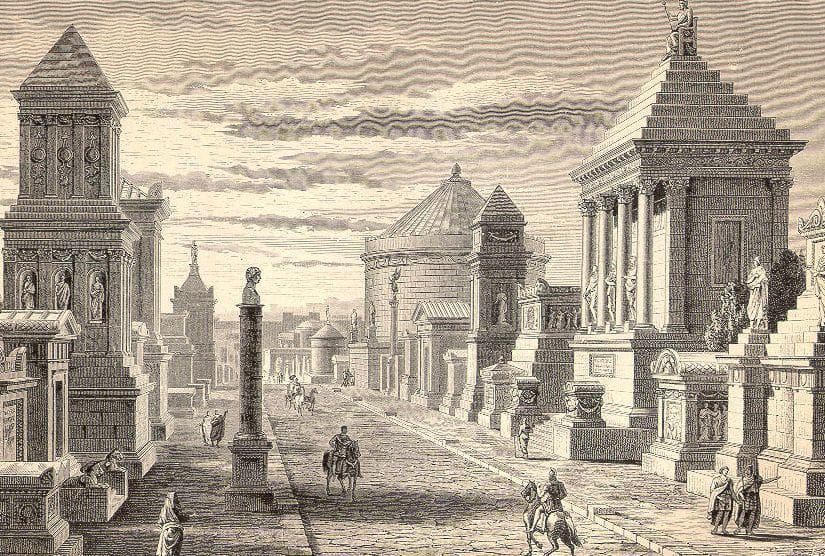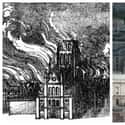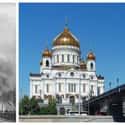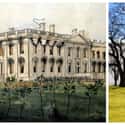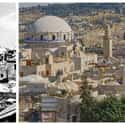(#13) World Trade Center
- Building complex
New York City lost part of its population, soul, and skyline on September 11, 2001, when the twin towers, the two tallest buildings at the World Trade Center, were brought down in a terrorist attack that took the lives of nearly 3,000 people. Designed by architect Minoru Yamasaki and built starting in 1966, the dual structures were 110 stories tall.
After the towers fell and workers cleared the detritus, the place where the buildings stood was turned into a memorial with two reflecting pools. A new single tower, symbolically 1,776 feet tall, replaced the previous two. One World Trade Center opened in 2014.
(#3) St Paul's Cathedral
- English Baroque
St. Paul's Cathedral in London, perched atop the city's highest point, is in its fourth iteration. The original wooden church, built in 604, was rebuilt three times after fires, Viking raids, and lightning strikes either brought down or severely damaged the structure. The current version, designed by Christopher Wren, went up after the Great Fire of London in 1666, and took 35 years to build. Although the cathedral was bombed during WWII, it withstood the damage.
For more than 250 years, the cathedral was London's tallest building; the dome is 365 feet high.
(#9) Yellow Crane Tower In Wuhan, China
The original version of China's Yellow Crane Tower, which overlooks the Yangtze River from atop a hill, was built in 223 as a watchtower, then became a scenic location. It was rebuilt more than seven times, and after a fire wiped out the tower in the late 1800s, it wasn't reconstructed until nearly 100 years later in 1981.
The eaves, covered in yellow glazed tiles, were designed to look like a crane unfurling its wings.
(#2) Cathedral of Christ the Saviour
The Russian Orthodox Cathedral of Christ the Savior in Moscow was built to commemorate the country's victory over Napoleon in 1812. Construction took more than 40 years, starting in 1839. Appropriately, Tchaivosky's "1812 Overture" premiered in 1882 outside the unfinished building.
Stalin's forces brought down the church in 1931 (pictured) to make way for a grandiose Palace of Soviets. That building project didn't happen, however, and the site became an open-air swimming pool. After the fall of the Soviet Union, the church was rebuilt from 1995 to 2000, based on the original design but with more modern materials and other features such as underground parking.
(#11) White House
- Neoclassical architecture
Built in the 1790s and first occupied by John Adams and his wife Abigail, the country's presidential abode was known as the "President's House" or "Executive Mansion" before Teddy Roosevelt officially dubbed it the "White House" (to distinguish it from governors' executive mansions) in 1901. After the British set the building on fire in 1814 during the War of 1812, the scorched structure (represented in the painting here by George Munger) was rebuilt.
Over the years, it's been renovated and expanded several times, most notably during the administrations of Teddy Roosevelt and Harry Truman. During Roosevelt's tenure, the West Wing was added. During Truman's presidency, the interior was gutted and completely redone. The White House now has 132 rooms; the only part of the original structure still standing is the exterior stone walls.
(#7) Hurva Synagogue
"Hurva," the name of this synagogue in the Jewish Quarter of Old Jerusalem, means "ruin," referring to its destruction several times since the 17th century, most recently during the 1948 Arab-Israeli conflict (it's pictured here in 1948 before it was wiped out).
Israel recaptured the Old City during the 1967 Six-Day War, but because of debate about how to re-create the Hurva Synagogue, didn't start construction on a modern-replica replacement until the 2000s.
New Random Displays Display All By Ranking
About This Tool
As a great historical witness, historical buildings are receiving more and more attention and protection from various countries. But in the past, some old buildings were unfortunately destroyed for various reasons and later rebuilt. For example, the Dresden Frauenkirche was bombed during the Second World War. The reconstruction work began until Germany was reunified, and it eventually became a symbol of hope after the war. The church was rebuilt in 2005.
There are many rebuilt historical buildings worth visiting around the world, and governments have made great efforts to protect the various historical relics in the buildings. The generator simply introduced 13 famous buildings that were rebuilt.
Our data comes from Ranker, If you want to participate in the ranking of items displayed on this page, please click here.

